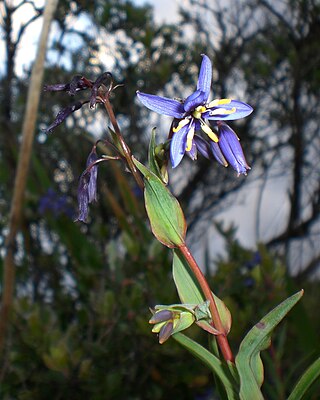
Dichopogon strictus, commonly known as chocolate lily, is a herbaceous perennial plant species native to Australia.

Stirlingia latifolia, commonly known as blueboy, is a species of flowering plant endemic to Western Australia.

Stypandra is a small genus of rhizomatous perennials in the family Asphodelaceae, subfamily Hemerocallidoideae. They are native to Australia and New Caledonia.

Tricoryne is a genus of perennial herbs in the family Asphodelaceae, subfamily Hemerocallidoideae. All species are native to Australia with two species extending to New Guinea; within Australia they occur in all 6 states and the Northern Territory.
- Tricoryne ancepsR.Br. - New Guinea, Queensland
- Tricoryne corynothecoidesKeighery - Western Australia
- Tricoryne elatiorR.Br. - Yellow Rush-lily - all 6 states plus Northern Territory
- Tricoryne humilisEndl. - Western Australia
- Tricoryne muricataBaker - Queensland
- Tricoryne platypteraRchb.f - New Guinea, Queensland
- Tricoryne simplexR.Br. - New South Wales
- Tricoryne tenellaR.Br. - Mallee Rush-lily - Western Australia, South Australia
Plantago debilis is a species of herb native to Australia. Common names include shade plantain and weak plantain.

Trichodesma zeylanicum, commonly known as Northern bluebell, camel bush or cattle bush, is a herb or shrub native to Australia.

Schelhammera is a genus of perennial flowering plants in the family Colchicaceae, comprising two species.

Rostellularia adscendens is an Australian plant species in the family Acanthaceae. It grows to between 10 and 50 cm high.

Calochlaena dubia, commonly known as soft bracken, false bracken, common ground fern or rainbow fern, is a small Australian fern in the treefern family Dicksoniaceae. It is very common within its range, and often seen growing under eucalyptus forest, often on the poorer quality soils. It is an easy plant to grow in the garden.

Lomatia silaifolia, commonly known as crinkle bush or parsley fern, is a plant of the family, Proteaceae native to eastern Australia. Naturally found in open forest, it grows as a small shrub 1–2 m high with highly pinnate leaves reminiscent of parsley. The white inflorescences appear in summer.

Isolepis is a genus of flowering plants in the sedge family, containing around 70 species. Isolepis is cosmopolitan, and often found in cool tropical and temperate climates in Africa and Australasia.

Isolepis inundata is a species of sedge native to Papua New Guinea, Australia and New Zealand. Common names include swamp club-rush. It was first described by prolific botanist Robert Brown in 1810.

Mentha satureioides, commonly known as native pennyroyal or creeping mint, is a species of herbaceous perennial native to southern + eastern Australia. It was first described by prolific botanist Robert Brown in 1810.
Needhamiella is a monotypic genus in the family Ericaceae. The sole species, Needhamiella pumilio, is a small shrub that is endemic to Western Australia.

Entolasia stricta, commonly known as wiry panic, is a species of right angled grass in the family Poaceae. It is found in eastern Australia on sandy or sandstone-based soils. The leaves are inrolled or curved inwards and somewhat rough to the touch. It first appeared in scientific literature in 1810 as Panicum strictum in the Prodromus Florae Novae Hollandiae, authored by the prolific Scottish botanist Robert Brown. It was given its current name in 1923.

Lomandra laxa is a perennial, rhizomatous herb found in the Australian states of New South Wales and Queensland.

Cymbopogon refractus, commonly known as barbed wire grass, is a species of perennial grass in the genus Cymbopogon of the family Poaceae. It is native to Australia.

Lomandra bracteata is a species of plant in the Asparagaceae family, first described in 1962 by Alma Theodora Lee.

Lomandra brevis is a species of plant in the Asparagaceae family, first described in 1962 by Alma Theodora Lee.

Lomandra cylindrica is a species of plant in the Asparagaceae family, first described in 1962 by Alma Theodora Lee.


















